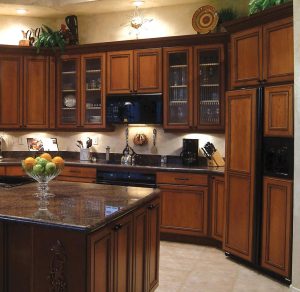Small changes often bring the biggest transformation. Sacramento Cabinet Refacing has quietly become one of the most elegant ways to breathe new life into a home without overwhelming cost or chaos. It’s not about tearing things apart but about revealing what’s been hidden under years of use. This process turns something familiar into something refreshing while preserving the foundation that already works.

The growing appeal of cabinet refacing lies in its balance between renewal and restraint. Instead of replacing entire structures, homeowners are learning that a simple resurfacing can redefine an entire room’s atmosphere. The technique brings both beauty and sustainability, proving that improvement doesn’t always require complete reconstruction. It’s a creative exercise in preservation, guided by precision and imagination.
Modern refacing techniques have advanced far beyond the basic idea of swapping doors and handles. Innovations in materials, finishes, and textures have transformed it into an art form that caters to both functionality and emotion. People are beginning to view their spaces not just as areas to maintain but as reflections of evolving identity. That realization adds emotional value to every refacing project.
What makes cabinet refacing fascinating is how it merges craftsmanship with psychology. The process gives people a chance to reclaim ownership of their space in a deeply personal way. There’s a quiet satisfaction in transforming something old into something refined with minimal waste. The change doesn’t just brighten a room—it renews the mood that lives inside it.
Many homeowners describe the experience as rediscovering their home’s potential. They realize that what once felt outdated can be reborn with the right touch of modern design. The act of choosing new surfaces and colors becomes symbolic of renewal, like giving the home a second voice. That creative interaction between owner and material turns refacing into a deeply human process.
What’s emerging in design conversations today is the notion of cabinet refacing as an ecological statement. By reusing existing materials, it minimizes waste and promotes conscious renovation. The process invites people to look at sustainability not as limitation but as opportunity. That mindset marks a shift toward ethical aesthetics where design choices align with responsibility.
Newer methods of refacing introduce materials that mimic luxury without the environmental footprint. Surfaces can now replicate textures once only found in high-end designs, but with durability and cost-efficiency. The outcome is sophistication accessible to more households. This democratization of design empowers people to elevate their living spaces without excess consumption.
The emotional reward of cabinet refacing often exceeds the visual outcome. People describe feeling renewed energy every time they step into their newly transformed kitchens or living areas. The small act of refinement seems to reignite pride in their home. It’s not just an upgrade—it’s a reset of atmosphere and attitude.
Another modern development is the rise of customizable finishes. Homeowners can now experiment with matte textures, high-gloss coatings, or natural tones that complement personal style. Each finish carries its own mood, influencing how light interacts with space. These subtle variations bring depth to rooms that once felt flat or uninspired.
Technology has also refined precision in refacing. Digital measurements and advanced cutting tools make the process faster and cleaner. That precision reduces human error while ensuring seamless alignment of materials. The result is a balance of traditional craftsmanship supported by modern efficiency.
Interestingly, cabinet refacing has become a preferred solution for those who value both aesthetics and emotional comfort. Full renovation often disrupts the rhythm of home life, while refacing offers transformation without turmoil. The calmness of the process allows people to stay connected to their environment during the upgrade. That gentle pace makes the change feel more natural and less invasive.
Designers are now exploring refacing as a storytelling medium. Each project carries a narrative of renewal, blending personal taste with design innovation. The materials chosen, from subtle grains to bold patterns, express individual stories without words. It’s a dialogue between the homeowner’s personality and the craftsmanship that brings it to life.
In recent years, cabinet refacing has also aligned with minimalist design philosophy. Instead of overwhelming spaces with excess, it refines what already exists. This approach highlights the beauty of simplicity and balance, inviting serenity into the home. The result feels modern yet timeless, like a whispered upgrade rather than a loud transformation.
Many experts note that refacing enhances the psychological well-being of homeowners. Living in refreshed surroundings stimulates creativity and calm. Even small changes in color tone or texture can influence mood and productivity. In this way, cabinet refacing becomes more than design—it becomes emotional architecture.
Another reason for its rising popularity is adaptability. Refacing can suit various interior themes, from contemporary to rustic, without losing coherence. The ability to adjust details like color schemes or hardware allows for customization that feels personal and refined. This flexibility keeps it relevant across styles and generations.
The economics of cabinet refacing also make it attractive. It delivers impact without the heavy investment or disruption of a full remodel. Homeowners find value in improvement that respects both their budget and their time. It’s an example of how practical design can coexist beautifully with elegance.
One of the most exciting modern developments is the fusion of refacing with smart design concepts. Integrating hidden lighting, sleek handles, or eco-friendly coatings creates a new layer of innovation. These details redefine the boundaries of what refacing can achieve. It’s proof that reinvention doesn’t have to be extreme—it just has to be intentional.
People who choose refacing often describe an emotional connection to the process. They appreciate that it honors what already exists instead of discarding it. This preservation mindset fosters gratitude and mindfulness. It reminds them that beauty can emerge from care, not just from novelty.
The color trends influencing cabinet refacing today lean toward natural tones and muted contrasts. Designers aim for harmony rather than dominance. The goal is to create depth through subtlety, allowing the cabinetry to complement rather than overpower. This nuanced approach gives spaces a gentle rhythm that feels welcoming and sophisticated.
Another trend is texture layering. Combining matte finishes with grain patterns adds tactile richness to rooms. It invites people not just to see their space differently but to feel it differently. This sensory engagement elevates the overall experience of being in the home.
Refacing has also encouraged homeowners to think more long-term about maintenance. Modern materials are designed for resilience and easy cleaning. This means the renewed look lasts longer and retains its charm with minimal upkeep. Durability, once secondary, is now part of the aesthetic value.
In smaller spaces, cabinet refacing has become a design strategy for visual expansion. Lighter tones, reflective surfaces, and clean lines make rooms appear larger and brighter. These optical effects contribute to comfort and openness, qualities highly valued in contemporary living. The technique thus becomes both aesthetic and spatially functional.
The rise of eco-friendly adhesives and coatings has added another layer of innovation. These materials ensure safety while reducing environmental impact. Homeowners can now enjoy luxury finishes without compromising health or sustainability. This conscious evolution redefines what responsible renovation means.
Interestingly, the cultural interpretation of refacing is shifting too. It’s no longer seen as a shortcut but as a conscious design decision. It represents mindfulness, care, and respect for what already exists. This shift mirrors a broader lifestyle change toward intentional living.
Many interior enthusiasts now associate cabinet refacing with renewal rituals. They view the process as symbolic cleansing—a removal of visual clutter and emotional stagnation. The refreshed cabinetry becomes a metaphor for starting anew. In this sense, refacing is not just physical but psychological transformation.
Some homeowners have begun combining refacing with subtle architectural adjustments. Adding soft lighting or open shelving enhances depth and functionality. These details turn cabinetry into a central design statement. The once-overlooked surfaces now anchor the visual identity of a space.
The narrative around cabinet refacing continues to evolve as technology and artistry merge. New tools enable more intricate detailing and seamless finishes. This precision blurs the line between handcrafted and machine-assisted design. The result is refinement that feels natural, balanced, and alive.
Refacing also contributes to the growing concept of slow design. Instead of rushing through upgrades, people now value deliberate transformation. They choose finishes, colors, and details that resonate deeply rather than trend briefly. This patience produces authenticity that endures far beyond fashion cycles.
As homes evolve into multifunctional spaces, refaced cabinetry adapts effortlessly. It transitions from storage to statement, from background to centerpiece. This flexibility ensures relevance even as interior trends shift. Every detail tells a story of reinvention anchored in timeless simplicity.
In the end, cabinet refacing represents more than surface renewal—it symbolizes thoughtful evolution. It teaches that elegance doesn’t require extravagance and that renewal can coexist with preservation. Through each grain, texture, and finish, it tells a story of care and intention. The true artistry lies not in changing everything but in seeing beauty where it already lives.
